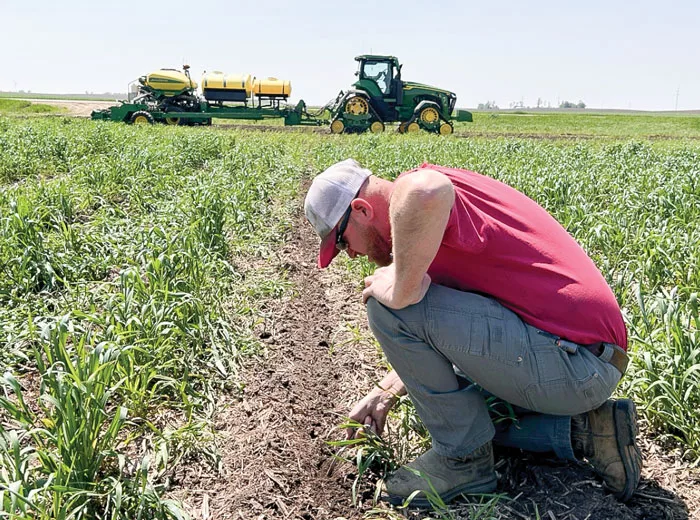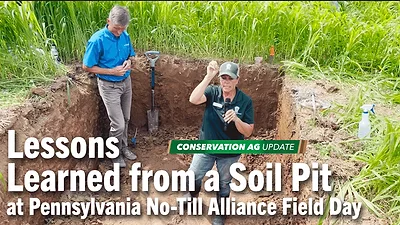Shawn Feikema grew tired of seeing his soils wash away in southwestern Minnesota, where they average about 29 inches of rain and 40 inches of snow annually. The final straw came in 2014 after storms dumped 9 inches of rain on his Luverne, Minn., farm in just two days.
“Mother Nature pushed us in a new direction,” he says. “We wanted to solve our erosion issues, which started us down the path of strip-till. We’re far enough north that no-till doesn’t really work that well for us on heavy clay soils that don’t warm up.”
The new direction marked a radical shift on the Feikema family’s third-generation farm, which includes a 4,000-head cattle feedlot, and 7,000 acres of corn, soybeans, oats, hybrid rye and alfalfa. Implementing large-scale conservation practices after generations of conventional tillage required some patience.
“Why not pick the three hardest things to pull off at once — trying to integrate manure, strip-till and cover crops all at the same time,” Feikema says. “We’ve had quite the journey, and there have been several learning experiences along the way.”
Learning Curve
By 2018, the Feikemas were strip-tilling all corn acres after selling their conventional tillage equipment. They use an Environmental Tillage Systems (ETS) SoilWarrior to make strips in the fall. Soybean acres see a mix of no-till and strip-till, depending on residue load and soil conditions.
It took Feikema a couple years to clear some of the mental hurdles that came with such drastic changes. Seeing green fields in the spring and uneven residue created some doubt, he admits, especially when neighbors and landowners questioned what was going on.
“The soil was so dead you couldn’t find a worm in it…”
“You’ve got residue build-up, the soil is adjusting, and you might not fully see the benefits until year 2 or 3,” Feikema says. “Just stick with it.”
Feikema aims for a corn-corn-soybean-small grain rotation. He’s seen a significant yield bump since adding small grains to the operation.
“Just by breaking up the rotation, we picked up 20-30 bushels per acre on corn the year after small grains and another 5 bushels of soybeans the year after that,” Feikema says.
Reviving the Soil
Cover crops reduce erosion and improve water infiltration in Feikema’s heavy clay soils, which have granite ledge rock underneath.
Shawn’s wife, Becky, who manages their cover crop selection, says their top-performing mixes include oats, berseem and red clover, flax, vetch, peas, jackhammer radishes, turnips, kale and occasionally sunn hemp and buckwheat.
The cover crops are usually drilled in immediately after oats and hybrid rye harvest in July and August.
“Ahead of corn, rye is about all we can make work because it’s just too cold,” Feikema says.
Reviving the Soil with Strip-Till, Covers & Livestock
Shawn Feikema took farmers inside his switch to strip-till and shared his cover crop and manure application strategies during a classroom session at the 2024 National Strip-Tillage Conference. Click here to watch Feikema’s presentation. The 2024 National Strip-Tillage Conference Video Replays are brought to you by ForGround by Bayer.
“Before using strip-till and cover crops, the soil was so dead you couldn’t find a worm in it,” he adds. “But when I started digging around after planting recently, there were worms all over the place. It was one of those moments where we really saw the benefits of all these changes.”
The feedlot provides some flexibility to experiment with cover crops and small grains because in the worst-case scenario, they can feed it to the cows. The Feikemas also lease some of their cover-cropped fields to neighbors for fall grazing.
Manure Management
Manure makes up most of Feikema’s nutrient management plan. Every acre gets manure at some point during the year, either dry manure from the feedlot, or liquid swine manure purchased through local contracts.
Custom applicators inject the swine manure 7-8 inches deep with vertical-till injector (VTI) bars in the fall.
“We’re applying the manure directly in a strip in the fall and then we either freshen it with the SoilWarrior 5-7 days later, or plant directly on the manure strip without freshening it in the spring,” Feikema says. “I’ve tried freshening the strips in the spring if I couldn’t in the fall, but usually it’s too wet and we do more damage than good.
“With the variability of manure, we’ll sometimes apply at least 30 pounds of fertilizer with a weed and feed sprayer pass, just to get a little bit of nitrogen in there because it takes time for that manure to break down and become available to the plant.”
At the end of the day, farming is about more than just yield, it’s about setting future generations up for success, Feikema says, which is a big reason why he switched to strip-till.
“We’re not perfect, but we’re doing everything we can to be the best stewards of the Earth that God’s given us. We’re trying to do it through generations of mentorship and passing it on because there are a lot of things in this world you can do without, but you can’t do without food.”







